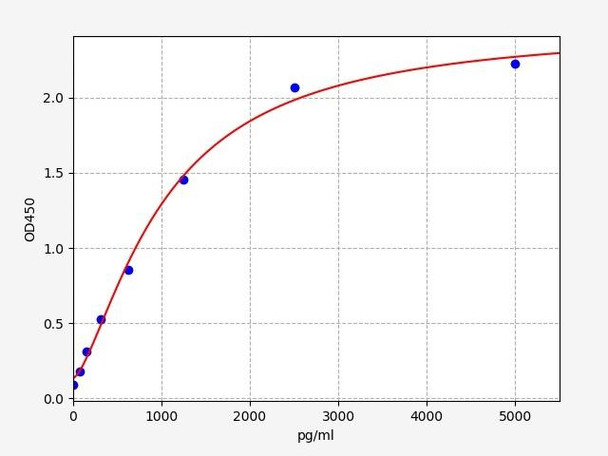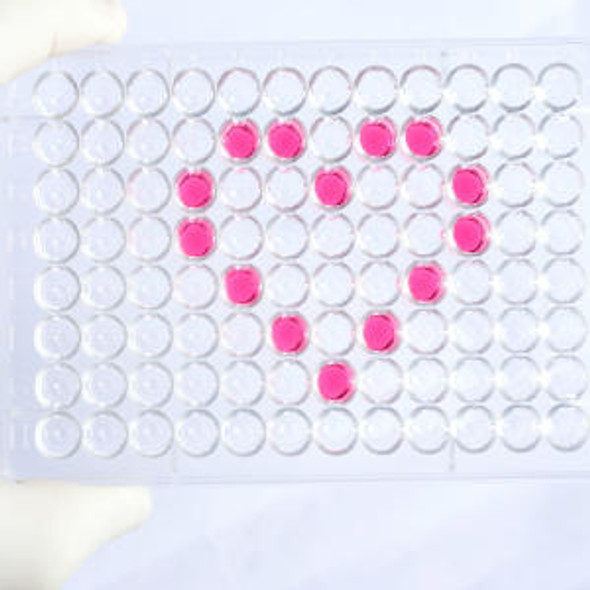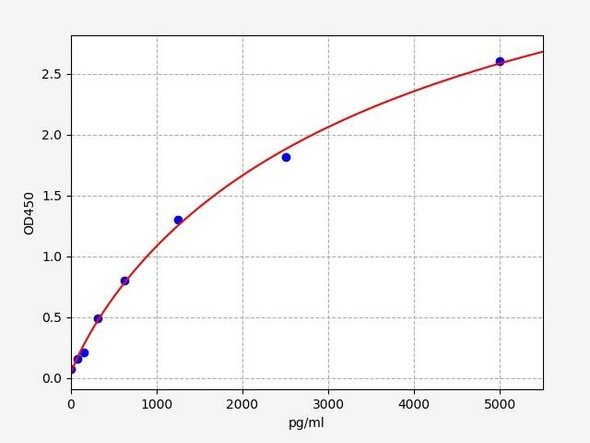Human GATA3(GATA Binding Protein 3) ELISA Kit
- SKU:
- HUFI03245
- Product Type:
- ELISA Kit
- Size:
- 96 Assays
- Uniprot:
- P23771
- Sensitivity:
- 46.875pg/ml
- Range:
- 78.125-5000pg/ml
- ELISA Type:
- Sandwich ELISA, Double Antibody
- Synonyms:
- GATA binding factor 3, GATA binding protein 3, GATA3, HDR
- Reactivity:
- Human
Description
| Product Name: | Human GATA3(GATA Binding Protein 3) ELISA Kit |
| Product Code: | HUFI03245 |
| Size: | 96 Assays |
| Alias: | GATA binding factor 3, GATA binding protein 3, GATA3, HDR |
| Detection method: | Sandwich ELISA, Double Antibody |
| Application: | This immunoassay kit allows for the in vitro quantitative determination of Human GATA3 concentrations in serum plasma and other biological fluids. |
| Sensitivity: | 46.875pg/ml |
| Range: | 78.125-5000pg/ml |
| Storage: | 4°C for 6 months |
| Note: | For Research Use Only |
| Recovery: | Matrices listed below were spiked with certain level of Human GATA3 and the recovery rates were calculated by comparing the measured value to the expected amount of Human GATA3 in samples. Enquire for more information. |
| Linearity: | The linearity of the kit was assayed by testing samples spiked with appropriate concentration of Human GATA3 and their serial dilutions. The results were demonstrated by the percentage of calculated concentration to the expected. Enquire for more information. |
| CV(%): | Intra-Assay: CV<8% Inter-Assay: CV<10% |
| Component | Quantity | Storage |
| ELISA Microplate (Dismountable) | 8×12 strips | 4°C for 6 months |
| Lyophilized Standard | 2 | 4°C/-20°C |
| Sample/Standard Dilution Buffer | 20ml | 4°C |
| Biotin-labeled Antibody(Concentrated) | 120ul | 4°C (Protect from light) |
| Antibody Dilution Buffer | 10ml | 4°C |
| HRP-Streptavidin Conjugate(SABC) | 120ul | 4°C (Protect from light) |
| SABC Dilution Buffer | 10ml | 4°C |
| TMB Substrate | 10ml | 4°C (Protect from light) |
| Stop Solution | 10ml | 4°C |
| Wash Buffer(25X) | 30ml | 4°C |
| Plate Sealer | 5 | - |
Other materials and equipment required:
- Microplate reader with 450 nm wavelength filter
- Multichannel Pipette, Pipette, microcentrifuge tubes and disposable pipette tips
- Incubator
- Deionized or distilled water
- Absorbent paper
- Buffer resevoir
| Uniprot | P23771 |
| UniProt Protein Function: | GATA3: a transcriptional regulator central in Th2 cell differentiation. Inhibits breast cancer growth and pulmonary breast cancer metastasis. Represses INK4C transcription, constrains luminal progenitor cell expansion, and suppresses luminal tumorigenesis in the mammary gland. High GATA3 and low INK4C expression predicts a favorable patient outcome in luminal A type breast tumors. IFN-lambda1 (IL-29) inhibits GATA3 expression and suppresses Th2 responses in human T cells. GATA3 haploinsufficiency leads to HDR (hypoparathyroidism, deafness, and renal dysplasia) syndrome. Two alternatively spliced human isoforms have been described. |
| UniProt Protein Details: | Protein type:Transcription factor Chromosomal Location of Human Ortholog: 10p15 Cellular Component: nucleoplasm; nuclear chromatin; nucleolus; nucleus Molecular Function:protein dimerization activity; protein binding; DNA binding; zinc ion binding; interleukin-2 receptor binding; transcription coactivator activity; transcription factor binding; transcription factor activity Biological Process: developmental growth; positive regulation of transcription, DNA-dependent; cell maturation; ear development; cell fate determination; uterus development; T cell receptor signaling pathway; post-embryonic development; negative regulation of interleukin-2 production; norepinephrine biosynthetic process; regulation of neuron apoptosis; erythrocyte differentiation; anatomical structure formation; mesonephros development; kidney development; regulation of cytokine biosynthetic process; response to drug; thymic T cell selection; anatomical structure morphogenesis; inner ear morphogenesis; positive regulation of signal transduction; embryonic hemopoiesis; response to virus; negative regulation of fat cell differentiation; parathyroid gland development; negative regulation of mammary gland epithelial cell proliferation; response to ethanol; positive regulation of T cell differentiation; response to estrogen stimulus; positive regulation of transcription from RNA polymerase II promoter; pro-T cell differentiation; negative regulation of transcription, DNA-dependent; regulation of CD4-positive, alpha beta T cell differentiation; transcription from RNA polymerase II promoter; lens development in camera-type eye; axon guidance; phosphoinositide 3-kinase cascade; TOR signaling pathway; neuron migration; defense response; negative regulation of transcription from RNA polymerase II promoter; signal transduction; negative regulation of cell cycle; positive regulation of interleukin-4 production; negative regulation of cell proliferation; sympathetic nervous system development; negative regulation of interferon-gamma production; response to gamma radiation; type IV hypersensitivity; pharyngeal system development; thymus development; in utero embryonic development; male gonad development; humoral immune response; positive regulation of protein kinase B signaling cascade; negative regulation of inflammatory response; innate immune response; regulation of histone H3-K4 methylation; T-helper 2 cell differentiation; blood coagulation Disease: Hypoparathyroidism, Sensorineural Deafness, And Renal Disease |
| NCBI Summary: | This gene encodes a protein which belongs to the GATA family of transcription factors. The protein contains two GATA-type zinc fingers and is an important regulator of T-cell development and plays an important role in endothelial cell biology. Defects in this gene are the cause of hypoparathyroidism with sensorineural deafness and renal dysplasia. [provided by RefSeq, Nov 2009] |
| UniProt Code: | P23771 |
| NCBI GenInfo Identifier: | 120962 |
| NCBI Gene ID: | 2625 |
| NCBI Accession: | P23771.1 |
| UniProt Secondary Accession: | P23771,Q5VWG7, Q5VWG8, Q96J16, |
| UniProt Related Accession: | P23771 |
| Molecular Weight: | 443 |
| NCBI Full Name: | Trans-acting T-cell-specific transcription factor GATA-3 |
| NCBI Synonym Full Names: | GATA binding protein 3 |
| NCBI Official Symbol: | GATA3Â Â |
| NCBI Official Synonym Symbols: | HDR; HDRSÂ Â |
| NCBI Protein Information: | trans-acting T-cell-specific transcription factor GATA-3; GATA-binding factor 3 |
| UniProt Protein Name: | Trans-acting T-cell-specific transcription factor GATA-3 |
| UniProt Synonym Protein Names: | GATA-binding factor 3 |
| Protein Family: | GATA-binding factor |
| UniProt Gene Name: | GATA3Â Â |
| UniProt Entry Name: | GATA3_HUMAN |
*Note: Protocols are specific to each batch/lot. For the correct instructions please follow the protocol included in your kit.
Before adding to wells, equilibrate the SABC working solution and TMB substrate for at least 30 min at 37°C. When diluting samples and reagents, they must be mixed completely and evenly. It is recommended to plot a standard curve for each test.
| Step | Protocol |
| 1. | Set standard, test sample and control (zero) wells on the pre-coated plate respectively, and then, record their positions. It is recommended to measure each standard and sample in duplicate. Wash plate 2 times before adding standard, sample and control (zero) wells! |
| 2. | Aliquot 0.1ml standard solutions into the standard wells. |
| 3. | Add 0.1 ml of Sample / Standard dilution buffer into the control (zero) well. |
| 4. | Add 0.1 ml of properly diluted sample ( Human serum, plasma, tissue homogenates and other biological fluids.) into test sample wells. |
| 5. | Seal the plate with a cover and incubate at 37 °C for 90 min. |
| 6. | Remove the cover and discard the plate content, clap the plate on the absorbent filter papers or other absorbent material. Do NOT let the wells completely dry at any time. Wash plate X2. |
| 7. | Add 0.1 ml of Biotin- detection antibody working solution into the above wells (standard, test sample & zero wells). Add the solution at the bottom of each well without touching the side wall. |
| 8. | Seal the plate with a cover and incubate at 37°C for 60 min. |
| 9. | Remove the cover, and wash plate 3 times with Wash buffer. Let wash buffer rest in wells for 1 min between each wash. |
| 10. | Add 0.1 ml of SABC working solution into each well, cover the plate and incubate at 37°C for 30 min. |
| 11. | Remove the cover and wash plate 5 times with Wash buffer, and each time let the wash buffer stay in the wells for 1-2 min. |
| 12. | Add 90 µl of TMB substrate into each well, cover the plate and incubate at 37°C in dark within 10-20 min. (Note: This incubation time is for reference use only, the optimal time should be determined by end user.) And the shades of blue can be seen in the first 3-4 wells (with most concentrated standard solutions), the other wells show no obvious color. |
| 13. | Add 50 µl of Stop solution into each well and mix thoroughly. The color changes into yellow immediately. |
| 14. | Read the O.D. absorbance at 450 nm in a microplate reader immediately after adding the stop solution. |
When carrying out an ELISA assay it is important to prepare your samples in order to achieve the best possible results. Below we have a list of procedures for the preparation of samples for different sample types.
| Sample Type | Protocol |
| Serum | If using serum separator tubes, allow samples to clot for 30 minutes at room temperature. Centrifuge for 10 minutes at 1,000x g. Collect the serum fraction and assay promptly or aliquot and store the samples at -80°C. Avoid multiple freeze-thaw cycles. If serum separator tubes are not being used, allow samples to clot overnight at 2-8°C. Centrifuge for 10 minutes at 1,000x g. Remove serum and assay promptly or aliquot and store the samples at -80°C. Avoid multiple freeze-thaw cycles. |
| Plasma | Collect plasma using EDTA or heparin as an anticoagulant. Centrifuge samples at 4°C for 15 mins at 1000 × g within 30 mins of collection. Collect the plasma fraction and assay promptly or aliquot and store the samples at -80°C. Avoid multiple freeze-thaw cycles. Note: Over haemolysed samples are not suitable for use with this kit. |
| Urine & Cerebrospinal Fluid | Collect the urine (mid-stream) in a sterile container, centrifuge for 20 mins at 2000-3000 rpm. Remove supernatant and assay immediately. If any precipitation is detected, repeat the centrifugation step. A similar protocol can be used for cerebrospinal fluid. |
| Cell culture supernatant | Collect the cell culture media by pipette, followed by centrifugation at 4°C for 20 mins at 1500 rpm. Collect the clear supernatant and assay immediately. |
| Cell lysates | Solubilize cells in lysis buffer and allow to sit on ice for 30 minutes. Centrifuge tubes at 14,000 x g for 5 minutes to remove insoluble material. Aliquot the supernatant into a new tube and discard the remaining whole cell extract. Quantify total protein concentration using a total protein assay. Assay immediately or aliquot and store at ≤ -20 °C. |
| Tissue homogenates | The preparation of tissue homogenates will vary depending upon tissue type. Rinse tissue with 1X PBS to remove excess blood & homogenize in 20ml of 1X PBS (including protease inhibitors) and store overnight at ≤ -20°C. Two freeze-thaw cycles are required to break the cell membranes. To further disrupt the cell membranes you can sonicate the samples. Centrifuge homogenates for 5 mins at 5000xg. Remove the supernatant and assay immediately or aliquot and store at -20°C or -80°C. |
| Tissue lysates | Rinse tissue with PBS, cut into 1-2 mm pieces, and homogenize with a tissue homogenizer in PBS. Add an equal volume of RIPA buffer containing protease inhibitors and lyse tissues at room temperature for 30 minutes with gentle agitation. Centrifuge to remove debris. Quantify total protein concentration using a total protein assay. Assay immediately or aliquot and store at ≤ -20 °C. |
| Breast Milk | Collect milk samples and centrifuge at 10,000 x g for 60 min at 4°C. Aliquot the supernatant and assay. For long term use, store samples at -80°C. Minimize freeze/thaw cycles. |










